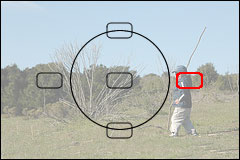Digital SLR Autofocus Systems
Digital SLR autofocus systems come with a wide variety of individual focus points.
In some sense, this makes comparing two different cameras quite easy: one camera might have 3 autofocus points while another has 9.
But which one has the better system?
Unfortunately the obvious conclusion here is not always the correct one. Before you write off a 3-point autofocus system, it's worth trying out the camera for yourself to judge its speed and accuracy.
You might find the results surprising.
The Foundation of Autofocus
Old SLR cameras didn't offer a huge number of autofocus points: there was one, and it was in the dead center of the viewfinder.
This made logical sense, since you usually point the camera straight at the subject you want to photograph.
While this kept the camera technology simple, it turned off-center compositions into a three-step process:
- Point the center of your camera (with the AF point) straight at your subject
- Push down on the shutter button halfway to engage the autofocus
- While holding down the button, re-compose so that the subject is off-center
It also led to a lot of botched photos when the camera decided (for whatever reason) to focus on the background rather than your primary subject.
Both of these problems have been solved with modern digital SLRs, since every camera has more than one autofocus point.
SLR Autofocus Arrangements
What follows are some of the most common arrangements that you'll find in digital SLR autofocus systems.
These arrangements suppose that you are looking through the camera viewfinder and that you are holding the camera horizontally, not vertically.
- 3-point autofocus systems are arranged with one point in the center and two off to the sides
- 5-point systems are the same as a 3-point setup, with additional points above and below the center point
- 9-point arrangements place the autofocus points in a diamond pattern around the center point
- 11-point systems spread out the autofocus points to cover the viewfinder

The reason for all of these autofocus points is to make it easier for photographers to create off-center compositions and still get the focus right.
For example, let's say that you have a five-point autofocus system and your primary subject is standing off to the right. If your camera is set up correctly, it will choose the right point to use for autofocus instead of the center one.
Many autofocus systems will light up the point the camera is using, which is a great visual cue about where the camera is focusing.
Are More Points Better?
The answer to this questions is vague: it depends. The thing that it depends on is what you like to photograph.
Portrait and landscape photographers can get by with a limited number of focus points, but die-hard action photographers will benefit from more.
A higher number of focus points ensure greater focus accuracy when your subject is moving all over the viewfinder.
Take me: I enjoy photographing dogs, subjects who rarely sit still to have a portrait taken. In order to capture them and ensure focus, I use a camera with a 9-point autofocus system.
The camera dynamically selects the correct autofocus point depending upon where the dog is in the viewfinder.
I would get a lot more blurry photographs with a 3 or even 5-point autofocus system, because there would be more opportunity for the dog to be in a part of the frame where there were no autofocus points.
One Shot vs. Continuous Autofocus
Beyond just the number of points a camera has, every digital SLR camera also includes several types of autofocus modes.
The two most common are called one shot and continuous autofocus.
One Shot
One shot autofocus is the mode to use for non-moving subjects.
You press halfway down on the shutter release button, the camera picks an autofocus point to use, focuses and then (unless you've disabled it) beeps at you.
If you want to change where the camera is focusing, you must release the shutter button, point the camera at something else, push halfway down on the shutter again and let the camera autofocus.
This approach works great for landscape, portrait, macro or still-life work: anytime your subject is still and you have enough time to get accurate focus.
Continuous
I think that continuous autofocus was created for parents trying to photograph their children.
 |
 |
 |
The little bundles of energy NEVER stop moving around, and won't sit still to have their portrait taken.
Nine times out of ten, they head straight for the camera the minute they see that you're trying to "capture the moment".
For little tykes - or any subject in constant motion - continuous autofocus is a blessing.
In this mode, you press the shutter release button halfway down, the camera picks an autofocus point and focus is set.
The big difference between this and one-shot mode is that if you continue to hold down the shutter button halfway, the camera will continue to adjust focus as your subject moves around the viewfinder.
This is especially helpful if your subject is charging right at you - if you've got the camera on one-shot AF mode, you'll NEVER get anything in focus in this situation.
Key Difference
There's one more significant difference between these two digital SLR autofocus modes that's worth pointing out:
- In one-shot mode the camera will not take a photo until the focus is set
- In continuous mode, you can take photos even if the subject is not in focus
This is why it's possible to wind up with a LOT of blurry photos when you use the continuous autofocus mode.
However, when you're dealing with action subjects it's a far better thing to use continuous autofocus and wind up with half your photos blurry rather than using one-shot mode which can result in ALL your photos turning out blurry.
Buying Tip
Get a camera with more autofocus points if you:
- Want to take photos of subjects that don't stay still
- Want to take photos where the subject is off-center
Settle for less autofocus points if you:
- Take photos of non-moving subjects (especially landscapes)
| Digital SLR Home |

|




